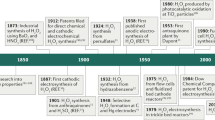Abstract
Preliminary experiments have been carried out on the mediated electrolytic synthesis of 1,2-epoxyhexane from 1-hexene. The electrochemical cell was an undivided parallel-plate reactor under galvanostatic operation at 25°C and 1 atm. The electro-active Br2/Br− couple acted as the mediating species. A dispersion of 1-hexene droplets in aqueous sodium bromide solution was generated by use of a static mixer. Current efficiency for organic species and chemical yield of epoxide were determined in order to investigate qualitatively the dependence of the overall electrolyzer performance upon flow rate, organic volume fraction, dispersed droplet size, and current density. The cell effluent was analyzed by gas chromatography. Epoxide current effciencies around 65% were obtained under operation conditions where the rate of bromine production by anodic reaction was sufficiently high so as to exceed the saturation concentration of hexene. Since the aqueous cell effluent was depleted of hexene, if was concluded that mass transfer from the organic phase into the aqueous phase was not able to replenish the electrolyte effectively.
Similar content being viewed by others
Abbreviations
- c c :
-
product concentration in aqueous phase (M)
- c d :
-
product concentration in organic phase (M)
- d :
-
diameter of dispersed organic droplets (μm)
- f :
-
organic volume fraction
- F :
-
Faraday's constant, 96 487 C mol−1
- I :
-
applied current (A)
- n :
-
number of electrons in electrode reaction
- Q :
-
total cell flow rate (ls−1)
References
H. Feess and H. Wendt, in ‘Technique of Electroorganic Synthesis’, Part III (edited by N. L. Weinberg and B. V. Tilak), Wiley-Interscience, New York (1982) p. 81.
R. Dworak and H. Wendt,Ber. Bunsenges. Phys. Chem. 81 (1977) 728.
R. Dworak and H. Wendt,Ber. Bunsenges. Phys. Chem. 81 (1977) 864.
P.-Y. Lu and R. C. Alkire,J. Electrochem. Soc. 131 (1984) 1059.
H. Feess and H. Wendt,Ber. Bunsenges. Phys. Chem. 85 (1981) 914.
M. M. Baizer and H. Lund, ‘Organic Electrochemistry’, Marcol Dekker, New York (1983) Chapter 26.
T. Shono,Tetrahedron 40 (1984) 811.
T. Shono, ‘Electroorganic Chemistry as a New Tool in Organic Synthesis’, Springer, Berlin (1984) p. 114.
R. E. W. Jansson and K. J. Ellis,J. Appl. Electrochem. 13 (1983) 657.
V. F. Melnikov, V. J. Koshutin and V. A. Smirnov,Zh. Obshch. Khim. 45 (1975) 2105.
J. D. Lisius, Electrochemical synthesis of propylene oxide with alternating and direct current', Ph.D. Thesis, University of Illinois, Urbana, Illinois (1985).
T. Bejerano, S. Germain, F. Goodridge and A. R. Wright,Trans. Inst. Chem. Eng. 58 (1980) 28.
J. M. Fenton, ‘Investigation of flow-by porous electrodes with two-phase electrolyzers’, Ph. D. Thesis University of Illinois, Urbana, Illinois (1984).
J. W. Koehler, “Preliminary studies on the mediated electrolytic epoxidation of hexene in a two-phase system’, Senior Thesis, University of Illinois, Urbana, Illinois (1985).
F. D. Rossini, “Selected Values of Physical and Thermodynamic Properties of Hydrocarbons and Related Compounds’, Carnegie Press, Pittsburgh, Pennsylvania (1953) p. 239.
C. McAnliffe,J. Phys. Chem. 70 (1966) 1267.
S. J. Chen, KTEK-5, Kenics Corp., Danvers, Massachusetts (1972).
Author information
Authors and Affiliations
Rights and permissions
About this article
Cite this article
Alkire, R., Köhler, J. Indirect electrochemical epoxidation of hexene in a liquid-liquid electrolyte. J Appl Electrochem 18, 405–409 (1988). https://doi.org/10.1007/BF01093755
Received:
Revised:
Issue Date:
DOI: https://doi.org/10.1007/BF01093755




